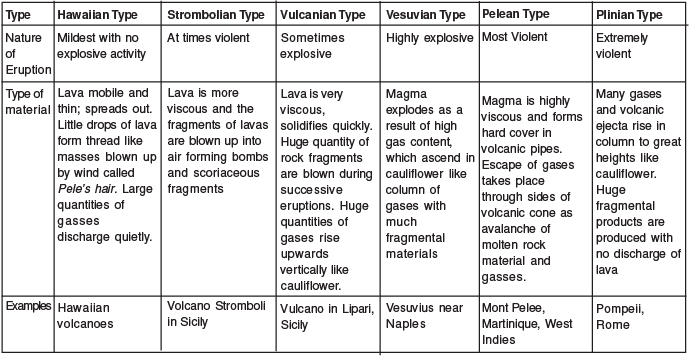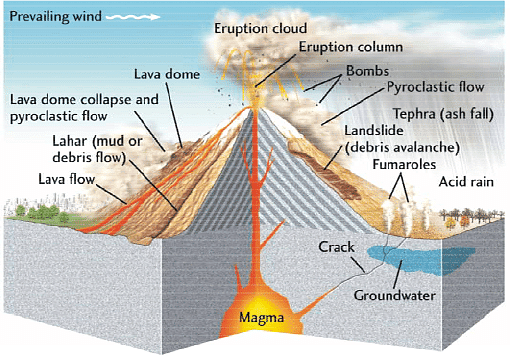UPSC Exam > UPSC Notes > Geology Optional Notes for UPSC > Volcanoes—Causes and Products
Volcanoes—Causes and Products | Geology Optional Notes for UPSC PDF Download
| Table of contents |

|
| Understanding Volcanoes: Causes, Types, and Characteristics |

|
| Understanding Volcanic Landforms, Products, and Effects |

|
| Distribution of Volcanic Belts |

|
| Tsunami |

|
Understanding Volcanoes: Causes, Types, and Characteristics
The Origin of Volcanoes
- Magma, the molten rock beneath the Earth's surface, is less dense than surrounding rocks, causing it to rise towards the surface.
- As magma accumulates, it fractures the lithosphere along weak zones, eventually finding a pathway to the surface through vents or fissures.
- Volcanic activity occurs as hot materials, including lava, pyroclastics, and gases, erupt through these openings.
The Definition and Scope of Volcanism
- The term "volcano" is derived from Vulcan, the Roman god of fire and metalwork.
- Volcanism encompasses the geological processes that lead to the formation of volcanoes and volcanic rocks.
- It involves the eruption of molten rock (magma) onto the Earth's surface or other solid planetary bodies.
Occurrence of Volcanoes
- Volcanoes are not exclusive to Earth and can be found on other planets.
- Approximately 1500 volcanoes are considered active on Earth's surface.
- Volcanoes can take various forms, including cone-shaped structures and fissures, through which molten materials are ejected.
Risk and Importance
- Over 500 million people are estimated to be at risk from volcanic activity worldwide.
- Understanding volcanoes is crucial for mitigating the effects of dangerous eruptions and protecting vulnerable populations.
- The study of volcanoes, known as Volcanology, aids in improving our understanding of Earth's interior and geological processes.
Causes of Volcanism
- Interior Heat and Pressure: The Earth's interior heat causes magma to rise towards the surface through low-pressure zones, leading to volcanic eruptions.
- Radioactive Heat Accumulation: Radioactive decay within the Earth produces magma, which eventually erupts as volcanoes.
- Plate Tectonics: Movements of tectonic plates can cause melting and the eruption of molten material along plate boundaries, forming chains of volcanoes.
Classification of Volcanoes
- Based on Activity:
- Active Volcanoes: Erupt intermittently or continuously.
- Dormant Volcanoes: Show eruptions with significant lapses between activity.
- Extinct Volcanoes: Have not shown activity within recorded history.
- Based on Eruption Mode:
- Central Type: Products escape through a single vent, forming volcanic landforms.
- Fissure Type: Lava flows slowly through fissures, covering large areas.

- Based on Eruption Nature:
- Explosive Type: Lava is acidic and produces explosive eruptions.
- Quiet Type: Lava is basaltic and eruptions are less violent, allowing lava to spread over long distances.
- Other Types: Various other types exist, categorized by degrees of explosive activity and eruption nature.
Question for Volcanoes—Causes and ProductsTry yourself: What is the main cause of volcanic eruptions?View Solution
Notable Examples and Indices
Types of volcanism based on explosive activity and nature of eruption

- Pele's Hair: Named after the Hawaiian goddess of fire, it refers to fine strands of volcanic glass formed during eruptions.
- Stromboli: Known as the lighthouse of the Mediterranean due to its frequent eruptions of incandescent gases.
- Plinian Type: Named after Pliny the Younger, describing the violent eruption of Mount Vesuvius that destroyed Pompeii and Herculaneum.
- Volcanic Explosivity Index (VEI): Developed to measure the relative explosivity of volcanic eruptions.

Conclusion
- Volcanoes are dynamic geological features that play a significant role in shaping the Earth's surface and impacting human populations.
- Understanding the causes, types, and characteristics of volcanoes is essential for mitigating risks and protecting vulnerable communities.
- Ongoing research and study in Volcanology contribute to our broader understanding of Earth's interior processes and geological phenomena.
Understanding Volcanic Landforms, Products, and Effects
Volcanic Landforms
- Volcanic landforms are shaped by geological processes and subsequent actions on them.
- These landforms can be categorized into positive relief features, such as hills, mountains, cones, plateaus, and upland plains, and negative relief features, including craters, calderas, and tectonic depressions.
- Before delving into specific landforms, it's important to understand the typical characteristics of a volcano, often conical in shape with a crater at its summit.

Positive-Relief Features
- Lava Dome: Bulbous masses of rock formed by the squeezing out of lava, exhibiting steep sides and little lateral spreading.
- Cinder Cone: Volcanoes with central type eruptions, characterized by steep-sided slopes and built-up solid fragments known as pyroclasts.
- Composite Cone: Made up of alternating lava flows and pyroclastic material, resulting in a concave-shaped structure also known as "strato-volcanoes."
Question for Volcanoes—Causes and ProductsTry yourself: What is the term used to describe fine strands of volcanic glass formed during eruptions?View Solution
- Lava Cone: Formed by the heaping of lava during quiet eruptions, often referred to as "plug-dome."
- Shield Volcano: Built up by successive lava flows from a central vent, forming a plateau-like structure extending over several kilometers.

Negative-Relief Features
- Crater: A bowl-shaped pit found at the summit of volcanic mountains, surrounding the central vent.
- Caldera: A large, steep-walled basin-shaped depression formed when the overlying volcanic structure collapses due to rapid discharge of magma. Can be of explosive or subsidence types.
- Lava Tunnels: Formed when fluid lava drains through weak spots at the periphery of lava flows, creating tunnel-like structures.

Products of Volcanism
- Liquid: Magma, molten rock material consisting of mineral melt, is the primary product of volcanic eruptions. Upon reaching the surface, magma is referred to as lava, which can be either felsic (viscous) or mafic (less viscous).
- Solid: Solid materials of varying sizes, known as pyroclastic material, are ejected during eruptions. These include volcanic bombs, lapilli or cinder, volcanic ash, volcanic dust, tuff, and agglomerate.
- Gases: Volcanic eruptions release gases such as water vapor, ammonia, carbon dioxide, nitrogen, sulfur dioxide, chlorine, hydrogen chloride, hydrogen sulfide, hydrocarbon gases, and arsenic vapors.

Effects of Volcanism
- Destructive Effects: Loss of life and property, changes in landscape, destruction of towns, coverage of large areas by lava, disaster due to acid rain, and accompanying earthquakes leading to soil and agricultural destruction.
- Constructive Effects: Formation of fertile soil after weathering, discovery of precious and semi-precious stones, extensive production of ores and mineral deposits, and formation of crater and caldera lakes providing sources of fresh water.

Conclusion
- Volcanic landforms, products, and effects showcase the dynamic and impactful nature of volcanic activity on Earth's surface and ecosystems.
- Understanding these phenomena is crucial for assessing both the risks and benefits associated with volcanic regions and mitigating potential hazards to human populations and environments.
Distribution of Volcanic Belts
Major Volcanic Belts
- Volcanoes, both active and extinct, are primarily concentrated within three major volcanic belts on Earth's surface.
- Pacific Belt: Encircling the Pacific Ocean, often referred to as the "Ring of Fire."
- Atlantic Belt: Covering regions such as the West Indies, East Atlantic, Iceland, and St. Helena.
- Eurasian Belt: Encompassing areas like Italy, East Mediterranean, Myanmar, and Indonesia.
Distribution of volcanic belts in world map

Relationship between Earthquakes and Volcanic Belts
- Volcanic belts often coincide and overlap with earthquake belts on the world map.
- Observing the distribution of earthquakes, volcanic activity, and plate boundaries reveals a close relationship between these phenomena.
- These relationships indicate a connection between earthquake and volcanic activity with tectonic plate boundaries.
- Geologists noted the concentration of volcanoes around the Pacific Ocean's rim, earning it the nickname "Ring of Fire," even before the formulation of Plate Tectonic Theory.

Tsunami
Causes of Tsunamis
- A tsunami is triggered by sudden movements of the ocean floor, causing a rapid displacement of water.
- Various events can lead to the generation of tsunamis, including undersea earthquakes, landslides, large volcanic eruptions, or meteorite impacts in the ocean.
- These events disrupt a large volume of water, transforming it into a wave that can travel across the ocean at speeds up to 800 km per hour.
- While tsunamis may not be noticeable in deep ocean waters, they become highly destructive as they approach shallow coastal areas, where the waves steepen and pile up.
Effects of Tsunamis
- Tsunamis can have devastating effects on coastal communities, resulting in severe loss of life, property damage, and irreversible changes to the landscape.
- The severity of a tsunami's effects depends on factors such as the magnitude of the triggering event, the distance from the epicenter, and coastal geography.
- While small tsunamis occur regularly with minimal impact, large tsunamis, like the one in December 2004 in the Indian Ocean, can cause widespread destruction across multiple countries.
- Efforts, such as the development of early warning systems, are made to mitigate the impact of tsunamis and protect coastal communities.
Question for Volcanoes—Causes and ProductsTry yourself: What are the primary products of volcanic eruptions?View Solution
Conclusion
- Understanding the causes and effects of tsunamis is crucial for implementing effective disaster preparedness and mitigation measures.
- Efforts to monitor seismic activity, improve warning systems, and enhance coastal resilience are essential for minimizing the impact of tsunamis on vulnerable populations and infrastructure.
The document Volcanoes—Causes and Products | Geology Optional Notes for UPSC is a part of the UPSC Course Geology Optional Notes for UPSC.
All you need of UPSC at this link: UPSC
FAQs on Volcanoes—Causes and Products - Geology Optional Notes for UPSC
| 1. What are the main causes of volcanic eruptions? |  |
Ans. Volcanic eruptions are mainly caused by the movement of magma beneath the Earth's surface, which creates pressure and leads to the release of gases and volcanic material through the volcano's vent.
| 2. What are the different types of volcanoes? |  |
Ans. The main types of volcanoes are shield volcanoes, stratovolcanoes (composite volcanoes), cinder cone volcanoes, and lava dome volcanoes, each formed through different eruption styles and materials.
| 3. How do volcanic landforms differ from one another? |  |
Ans. Volcanic landforms can vary in shape and size depending on the type of eruption and the materials involved. Some common volcanic landforms include calderas, lava plateaus, volcanic craters, and volcanic islands.
| 4. What are the effects of volcanic eruptions on the environment? |  |
Ans. Volcanic eruptions can have various environmental effects, such as releasing ash and gases into the atmosphere, causing air pollution and affecting climate patterns. They can also lead to the formation of new landforms and influence ecosystems.
| 5. How are volcanic belts distributed around the world? |  |
Ans. Volcanic belts are typically found along tectonic plate boundaries, such as the Ring of Fire in the Pacific Ocean. They are also present in areas with hotspots, where magma from the mantle rises to the Earth's surface, creating volcanic activity.

|
Explore Courses for UPSC exam
|

|
Signup for Free!
Signup to see your scores go up within 7 days! Learn & Practice with 1000+ FREE Notes, Videos & Tests.
Related Searches

















